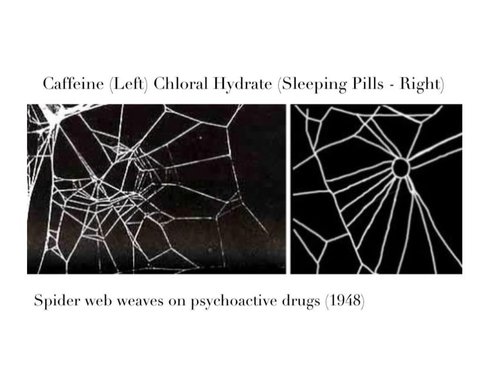What Happens to a Spider Web on LSD?
- Archive Threads
- Aug 18, 2021
- 2 min read

Welcome to the tenth insertion of DEMUR®, a series where we will be highlighting some of the most interesting topics in all of art. This week we’ll get caught up in the asymmetric beauty of drug-altered spider webs, and the experiments conducted by Peter N. Witt (1948).
Humans have been fascinated with the artistry of the spider web for centuries, their delicate yet highly effective ability perplexing researchers. This mix of curiosity inducing unknowns is exactly what piqued zoologist Herman Peter’s interest, the scientist determined to capture the insect working on camera. However, the spider refused to create under a lens, and seemed to only perform when the scientists happened to fall asleep. Noticing such after repetitive failure, Herman Peter requested the assistance of Swiss pharmacologist Peter N. Witt. The two needed to chemically alter the spider’s internal web-building cycle, shifting the activity from between 2-5am.

Being a pharmacologist, Peter Witt was naturally inclined to administer minute doses of psychoactive drugs such as amphetamine, mescaline, strychnine, LSD, and caffeine in hopes of altering the creature’s habitual cycle. Dosed through a diluted sugar water compound, each spider not only spun between 2-5am but created sporadic and inconsistent webs with varying differences between each drug. Although in theory the experiment failed, the obscurity behind each web delighted Witt who (at the time) was studying the abnormality of psychoactive drugs in the nervous system - on human subjects. He found the insects created unusual radii and smaller webs at 10 µg of caffeine/spider and further obscurities at 100 µg, other drugs creating just as obscure web patterning.

The research left untouched until 1995, a team at NASA then conducted a study with interest in determining the toxicity of chemicals through documentation of the spider web. Using marijuana incentivized utter disinterest, while LSD induced a psychedelic yet ineffective spinning technique. Finally with speed, the spider created a fast but asymmetric pattern, resulting with both a deeper understanding of altered cognitive function as well as an appreciation for the atypical.









Comentários